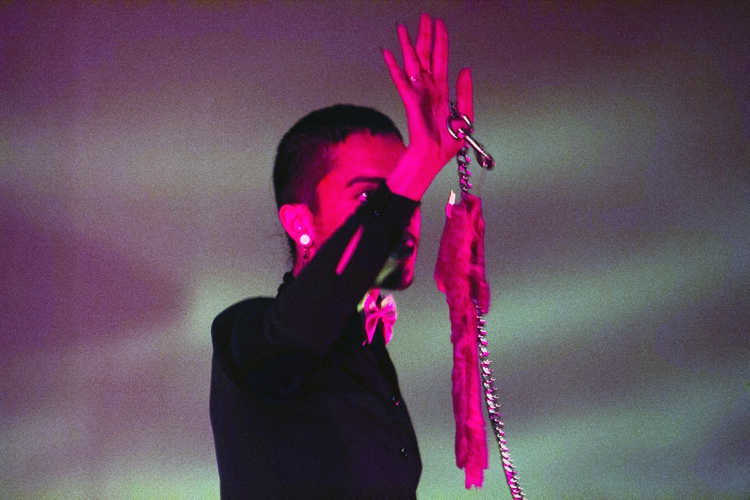Living Mythologies is a performance art show founded on ceremony, relevance and healing. The show, which took place Feb. 11 and Feb. 12 in Upper Herrick, featured five Queer, Trans and Intersex People of Color (QTIPOC) artists: Shruti Bala Purkaystha, who curated the performance, Edxie Betts, Jose Richard Aviles, Reyna Ripper and Chella Coleman. Each artist performed pieces centered around their individual experiences as QTIPOC-identifying individuals.
Adrienne Adams (senior), a campus and community organizer who works in Office of Community Engagement (OCE), first saw the performance in June at the Highways Performance Space in Santa Monica as a part of the Queer Arts Festival. With the support of the OCE, thirteen academic departments, six student affairs departments, three administrative offices and ten clubs including Black Student Alliance and Beauty Beyond Color, Adams helped bring the show to Occidental College. The raw quality of the performances and unconventional storytelling method struck Adams.
“It wasn’t a linear narrative trajectory, it wasn’t about coming of age or a clear coming-out story,” Adams said. “It was very much taking these raw, oftentimes mysterious experiences and transforming them into a performance in gritty, experimental ways that I appreciated. It leaves a lot of room open for interpretation rather than promoting a didactic sense of identity or of a certain type of politic.”
Edxie Betts performed a ceremony in which they danced, sang and used multi-media art aimed to question myth and fiction. During the ceremony, they read slips of paper on which audience members described problems they were experiencing. After reading the notes, Betts poured ink on them and proceeded to step on the ink-soaked pieces of paper. Betts views the ceremony as an opportunity to engage in resistance culture and to serve as a coping mechanism for healing from trauma. Betts hopes that the ceremony moves the audience and inspires reflection.
“I would hope that it moves them in some way whether it bothers them to where they’re very bothered or very pleased, or alleviated at least … The intention was to leave the audience feeling something … To question what they’re doing and have them reflect into themselves,” Betts said.
The subsequent piece, performed by Reyna Ripper, involved mixing harsh noises of gurgling throat sounds and buzzing flies. Their piece also included walking down the aisle of the chapel while waving a dangling piece of raw meat in the audience’s faces. Ripper drew on their family’s religious background to create an experience with an apocalyptic tone. Ripper intended for the meat to symbolize the physical body and used this metaphor to address the intergenerational traumas that remain from centuries of colonization. Through this dark piece, Ripper aimed to subvert power dynamics.
“What I’m hoping for myself in the process is the energy transfer in terms of power dynamics shifting,” Ripper said. “I find that when marginalized people reclaim their power that has been taken from them, there’s oftentimes an energy transfer in which one person feels empowered and someone else who’s usually in a position of power feels disempowered. When those energy levels are transferring, shifting, I get a euphoric rush in my body where I feel like that essence moving through my body.”
Other performances included Jose Richard Aviles, who danced to Latin music and sang about learning to love himself and his body. Chella Coleman performed a spoken word piece and sang about mental illness, self-harm and her intersecting identity. Betts, Ripper, Aviles and Coleman’s pieces were tied together by Shruti Bala Purkayastha, the curator who interspersed each performance with poetry. As the show concluded, the entire cast returned to the stage, marching together as Beyonce’s “Freedom” played in the background.
In a Q&A session after the performance, Ripper commented that their reclamation of power oftentimes makes people feel uncomfortable, but also maintained that they are not apologetic for how their self-expression makes others feel. In the same Q&A session, an audience member confirmed Ripper’s observation when they shared that there were times during the performance when they felt afraid.
Eli Plvan-Franke (sophomore) attended the Saturday show and found parts of the performance to be beyond his comprehension. He also realized that his lack of understanding was, in itself, a telling and significant response to the performance.
“I thought it was interesting because it seemed like there was a purposeful lack of explanation on their part because the main reason for doing it is to find a way that they best express themselves regardless of how other people feel,” Plvan-Franke said.
Through song, dance, poetry and performance art, Living Mythologies provoked, questioned and gripped the audience of Upper Herrick. The performance provided a space where QTIPOC artists, who are often marginalized for their identities, could perform without limitation, empowering themselves while critically provoking the viewers.
Love performance art? Email us at Weekly.oxy.edu or Tweet us @OxyWeekly
![]()




































